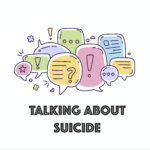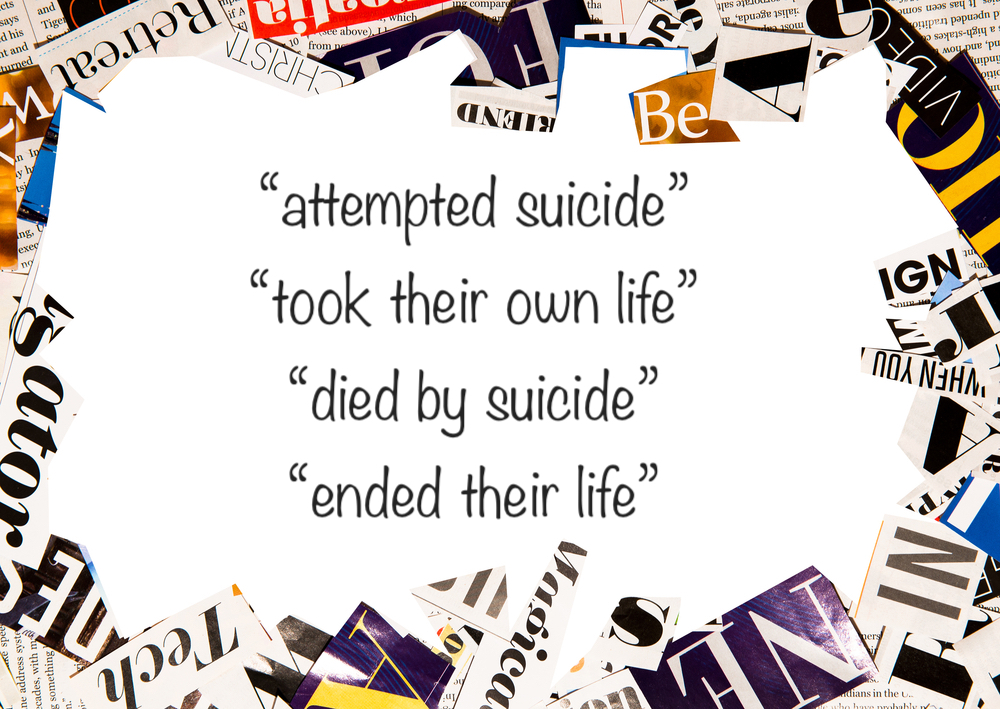
Language is known to have the power to influence people’s thoughts, opinions and memory (Ervin-Tripp S., 1967; Jones EF. et al, 1974; Whorf BL., 1956). The use of language and diagnostic labels when discussing mental health problems has been a point of contention in the field of mental health. However, the hierarchy of stigma attached to mental health diagnoses may prevent disclosure and help-seeking, along with impacting on experiences of support (Clement S. et al. 2015; Hemming L., 2018; Huggett C. et al, 2018; Richards V., 2018).
Suicidal experiences and deaths are highly stigmatised. The phrase “commit suicide” carries negative connotations as it originates from the historical treatment of suicide as a criminal act. However, this conflicts with the now legal status of suicide across the majority of countries worldwide. As a result, the phrase “commit suicide” is being actively discouraged in the media and academia (Freeman K., 2015; Maple M. et al, 2009; Mishara BL. et al, 2016).
Phrases such as “died by suicide” and “took one’s own life” have been suggested as alternatives to “commit suicide”. However, such phrases carry their own critique, e.g. “died by suicide” may remove a person’s agency in suicide and “took one’s own life” excludes the term suicide (Galasiński D. 2017, 2018). Therefore, choosing which language to use when describing suicidal experiences and death needs to be approached with careful consideration, but to date there is little research to guide this.
The present study by Padmanathan et al (2019) therefore aimed to:
…explore the views of people affected by suicide with regard to language used in relation to suicidal behaviour.

What is the most appropriate language to use when describing suicidal experiences and death?
Methods
The authors, some of whom had been personally affected by suicide, designed and distributed an anonymised online survey (via SurveyMonkey) which comprised of 33 Likert-style scale questions. Participants were asked to rate phrases relating to suicidal behaviour or self-harm, where the person either had or had not died, on a 5-point scale from 1 (“not acceptable”) to 5 (“acceptable”). The authors did not describe how they chose the phrases relating to suicidal behaviour or self-harm used in the survey. Participants were asked which descriptors from a drop-down list were most and least appropriate for describing suicidal behaviour and death. Participants were also given the opportunity to explain their answers and provide alternative via free text responses.
The authors promoted the online survey widely through their own academic networks, along with lived experience and charitable organisations in the United Kingdom (UK), Australia and United States of America (USA) via a combination of email, social media and organisation websites. The authors aimed the survey at people who were over 18 and had been affected by suicide. People were considered to have been affected by suicide if they or someone they knew had experienced thoughts of suicide or attempted suicide, or if anyone they knew had died by suicide.
Quantitative data were analysed using descriptive analysis. Qualitative data generated by free text responses to the most and least appropriate phrases were analysed using thematic content analysis.
Results
Of the 2,719 responses to the online survey, 1,679 (61.8%) were complete. The most common way in which participants had been affected by suicide was through knowing a close friend or relative who had attempted or died by suicide (n=879; 52.4%).
‘Non-fatal’ suicidal behaviour
- Participants selected “attempted suicide” as the most appropriate phrase to use (median=4; IQR=3-5). Participants stated that they perceived the phrase to be accurate, clear, neutral, to the point and reflected intention and seriousness of the behaviour.
- “Near Miss” was deemed the least appropriate (median=1; IQR=1-2) phrase by participants. Participants most commonly described this phrase as downplaying the seriousness of the behaviour and felt the phrase was insensitive, disrespectful and did not reflect suicidal intent. Also, some suggested that it implies failure, which could lead to further suicidal behaviour.
‘Fatal’ suicidal behaviour
- Participants selected “took their own life” (median=5; IQR=4-5) and “died by suicide” (median=5; IQR=3-5) as the most appropriate phrases to use. Participants thought that “took their own life” was softer in tone, descriptive, reflected an individual’s agency, and was preferred as it omitted the word suicide.
- “Topped themselves” (median=1; IQR=1-1) and “successful suicide” (median=1; IQR=1-2) were deemed the least appropriate. Participants described “successful suicide” as inappropriately framing suicide in a positive light, which could encourage suicide. Further, those bereaved by suicide found the term insensitive and distressing.
- Participants had conflicting views about the appropriateness of “committed suicide”. People who had been “affected by suicide through someone they knew” had the most varied opinions (median=3; IQR = 1-5). However, people who found the phrase acceptable, tended to have been “affected by suicide solely through their own experiences” (median=4; IQR = 3-5), whereas, “those whose experience of suicide was was exclusively through work or volunteering” found the phrase unacceptable (median=2; IQR = 1-3).
- Participants who favoured using the phrase “committed suicide” did not agree with the association with criminality and described the phrase as widely used, neutral and accurate.
- Participants who found the phrase “committed suicide” to be unacceptable most commonly thought this due to the implication of it being a criminal act. Further, some viewed the phrase as outdated.
Alternative phrases
Of the 1,679 responses, 188 suggested alternative phrases to describe suicidal behaviour and death:
- Phrases that include a statement which reflects the intention of the individual: “chose to” or “decided to”. Although some disagreed with such phrases as they believed it suggested the person had free will over their actions.
- Describing “underlying cause of death within the phrase rather than the method”. Some ideas comprised of “died by brain disease”, “mental illness”, “hopelessness” or “family rejection”.
- Some participants felt that the term “suicide” should not be avoided, arguing that this could be dangerous and may make it even harder for people to seek support with suicidal thoughts.

“Attempted suicide”, “took their own life” and “died by suicide” were deemed as the most appropriate phrases to describe suicidal behaviour.
Conclusions
The current paper examined the opinions of people affected by suicide about phrases to describe suicidal behaviour. Overall, it appears that opinions are varied and need to be considered in context of individual experiences.
The phrase “commit suicide” seemed to divide opinions the most. However, the majority of participants deemed the following phrases as most acceptable:
- “attempted suicide”,
- “took their own life”,
- “died by suicide” and
- “ended their life”.
The authors suggest that “academic and media guidelines should therefore promote the use of these phrases”.

How do we better implement the use of academic and media guidelines to appropriately describe suicide?
Strengths and limitations
The authors should be commended for involving people with lived experience of suicide in all stages of the study; this is a great example of how suicide research can be co-produced. Further, obtaining views about suicide-related language from people affected by suicide is essential as they could be the people most affected by choice of language in talking about suicide.
In the first study of its kind, a range of opinions were captured by using mixed-methods in a large sample size across several countries. However, the authors have acknowledged that suicide reporting guidance may differ across countries and so may have influenced the sample. Conducting studies which focus on one country at a time may help to tease out different views which may be culture specific and therefore carry more ecological validity.
It appears that no detail was provided as to how the phrases about suicidal behaviour were chosen. This should be considered as a limitation. Arguably, providing participants with pre-specified phrases limits the richness of opinions by people affected by suicide. It is also unknown how extensively the chosen phrases were used. It could be that phrases, such as, “commit suicide” were more familiar, which may provide some explanation as to the divided opinion of this phrase. Therefore, a more in-depth qualitative exploration would not only provide rigour to the current qualitative method and analysis, but could better inform the development of the survey. Future research could carry out individual and/or focus group interviews to identify phrases used to describe suicidal behaviour or self-harm and explore which phrases were most and least appropriate, along with the reasons for these choices.
There was some bias introduced through attrition as people with incomplete scores were “more likely to be younger, male, living in non-English speaking countries and more likely to have a lower level of education compared to those with complete quantitative responses.” However, the authors attempted to account for this by firstly conducting a descriptive analysis with complete quantitative data only and then conducting a sensitivity analysis including both complete and incomplete quantitative responses. Despite such efforts to account for bias introduced by attrition, the overall sample was over-represented by younger females with higher levels of education, which limits the views to this particular demographic. This representation issue talks to the notion that men find it harder to talk about suicide and therefore may be hesitant to openly identify themselves as someone affected by suicide for the purposes of research.

Given that suicide reporting guidelines differ between countries, should we consider conducting culture-specific studies to explore language use when talking about suicide?
Implications for practice
It is important to acknowledge that people affected by suicide have differing views over specific terms (e.g. “commit suicide”) and for clinicians and researchers to be respectful of individual language preferences. However, there is also a delicate balance where clinicians and researchers may also want to dispel myths and combat stigma, which may be perpetuated by the continued use of phrases such as “commit suicide”. The study does highlight concerns over phrases such as “near miss” and “successful suicide” encouraging suicidal behaviour, which suggests that these phrases should be discouraged.
From the perspective of a researcher in suicide prevention and stigma, I would be interested in what may influence people’s choice of language surrounding suicide. For instance, a few participants in the current study mentioned that some phrases were widely used. We know that the media has an influence over attitudes and attitude change relating to stigma (Angermeyer MC. et al. 2001; Sieff E. 2003). So, a potential avenue for future research could be to examine the influence of the media over choice of language in talking about suicidal behaviour and death and the stigma surrounding suicidal experiences and death.

The present study, provides scientific evidence which may help to better inform and implement media and academic guidance around reporting of suicidal experiences and death.
Statement of interests
There are no conflicts of interest.
Charlotte Huggett has conducted and published a research study which examines the experiences of stigma by people with mental health problems. Further, Charlotte is currently the Trial Manager of the CARMS study (Cognitive AppRoaches to coMbatting Suicidality), which is examining the efficacy of a Cognitive Behavioural Suicide Prevention (CBSP) therapy for people experiencing non-affective psychosis and suicidal thoughts and behaviours. Charlotte previously worked as a Project Coordinator on a pilot trial assessing the feasibility and acceptability of CBSP therapy for people on mental health inpatient wards with suicidal thoughts and behaviours.
Links
Primary paper
Padmanathan P, Biddle L, Hall K. et al (2019) Language use and suicide: An online cross- sectional survey (PDF). PLOS One 2019 14(6) e0217473. Doi: 10.1371/journal.pone.0217473
Other references
Angermeyer MC, & Schulze B (2001) Reinforcing stereotypes: How the focus on forensic cases in news reporting may influence public attitudes towards the mentally ill. International Journal of Law and Psychiatry 2001 24 469-486. doi: 10.1016/s0160-2527(01)00079-6 [PubMed abstract]
Clement S, Schauman O, Graham T. et al (2015) What is the impact of mental health-related stigma on help-seeking? A systematic review of quantitative and qualitative studies. Psychol Med 2015 45 11–27. doi: 10.1017/S0033291714000129 [PubMed abstract]
Ervin-Tripp S. (1967) An Issei Learns English (PDF). J Soc Issues. 1967 23(2) 78-90 Doi: 10.1111/j.1540-4560.1967.tb00577.x
Freeman K. Why You Shouldn’t Say “Committed Suicide”. The Mighty website, last accessed 29 Mar 2020.
Galasiński D. Committing to “commit”? Galasiński’s blog website, last accessed 29 Mar 2020.
Galasiński D. Suicide and agency. Galasiński’s blog website, last accessed 29 Mar 2020.
Hemming L. A hierarchy of stigma based on mental health diagnosis? The Mental Elf, 5 Apr 2018.
Huggett C, Birtel MD, Awenat YF, et al (2018) A qualitative study: experiences of stigma by people with mental health problems (PDF). Psychology and Psychotherapy: Theory, research and practice 2018 91(3) 380-397. Doi: 10.1111/papt.12167
Loftus EF, Palmer JC. (1974) Reconstruction of automobile destruction: An example of the interaction between language and memory (PDF). J Verbal Learning Verbal Behav 1974 13 585–589. Doi: 10.1016/S0022-5371(74)80011-3
Maple M, Edwards H, Plummer D, et al (2009) Silenced voices: hearing the stories of parents bereaved through the suicide death of a young adult child (PDF). Health Soc Care Community 2009 18 241–248. Doi: 10.1111/j.1365-2524.2009.00886.x
Mishara BL, Weisstub DN. (2016) The legal status of suicide: A global review. Int J Law Psychiatry 2016 44 54–74. Doi: 10.1016/j.ijlp.2015.08.032 [PubMed abstract]
Richards V. (2018) The importance of language in mental health care. The lancet Psychiatry 2018 5 460–461. Doi: 10.1016/S2215-0366(18)30042-7
Sieff E. (2003) Media frames of mental illnesses: The potential impact of negative frames. Journal of Mental Health 2003 12(3) 259-269. doi: 10.1080/0963823031000118249 [Abstract]
Whorf BL. (1956) Language, Thought, and Reality: Selected Writings of Benjamin Lee Whorf (PDF). Carroll JB, editor. Cambridge, MA: MIT Press.
Photo credits
- Photo by Jason Leung on Unsplash
- Photo by Artem Beliaikin on Unsplash

I find the suggestion for underlining cause from rather vague (“died by brain disease”) to blaming (“family rejection”). I can only imagine how a family member, who are most of the times already blaming themselves, would feel hearing or reading such an explanation. Blaming someone in describing what has happened would only create more stigma.
As someone who experienced the loss of a brother to suicide 30 years ago and speaks often about the experience to small groups, the results of this study seem accurate – especially about the widely diverging opinions about the phrase “committed suicide”. It is not offensive to me, but I have learned that it is highly offensive to others so I have chosen not to use it anymore.
I wouldn’t use any term with anyone if I knew that term offended them. However, I don’t believe “committed suicide” is inherently a bad thing to say. “Committed” just means that someone did something. You can “commit” any kind of action.